 |
Fort Snelling
St. Paul, Minnesota, USA
|
|
 |
Constructed: 1820-1825
Used by: United States
Conflicts in which it participated: None
Also known as: Fort St. Anthony
|
In 1803, the young United States approached the elderly France regarding the possibility of purchasing the city of New Orleans and its immediate surrounding area. "Mais bien súr," replied France in the person of Napoleon Bonaparte (1769-1821), "but as I am currently wearing my selling pants¹, would you be perhaps interested in 828,000 square miles of semi-prime real estate that reaches from New Orleans all the way to the future Canadian border, including land from fifteen of your future 'states?' "
|
 |
|
|
Napoleon, revealed by this conversation to possess a remarkable ability to divine future events², had secured the Louisiana Territory from Spain in 1800. 'Twas Boney's intention to use this vast North American expanse to create an empire in the Western Hemisphere, but France's recent inability to put down revolts on the island of St. Dominigue (which would later be named Haiti) led him to throw up his tiny hands and forsake any future plans in the New World. The United States, in the person of President Thomas Jefferson (1743-1826)³, purchased the Louisiana Territory from France for $15 million on April 30, 1803, and New Orleans was officially handed over to the United States on December 20. Jefferson swiftly saw to it that expeditions were organized to explore this enormous new addition to the United States. The most famous of these was the Lewis and Clark Expedition. This enterprise trailed its way through the central and northern reaches of today's United States, winding up at the mouth of the Columbia River betwixt the modern states of Oregon and Washington, where Fort Stevens would later be built.
|
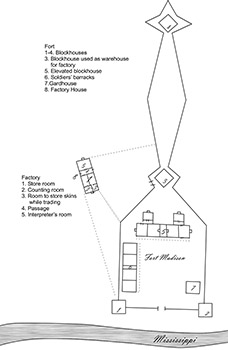 The ridiculously-shaped Fort Madison, the United States' first permanent fortification on the upper Mississippi River. The ridiculously-shaped Fort Madison, the United States' first permanent fortification on the upper Mississippi River. |
 |
A lesser-known expedition was that of Lieutenant Zebulon Pike (1779-1813), who in 1805 was ordered to search for the source of the Mississippi River, and/or cool places to put forts. Zeb & co. found that the confluence of the St. Peters (later named the Minnesota) and Mississippi Rivers would be an extremely cool place to put a fort, and convinced the local Dakota Indians to sell the United States a nine-square-mile plot overlooking that confluence, for the princely sum of $2,000. This agreement was called the Treaty of St. Peters, but is better known as Pike's Purchase. Zebulon went on to have an interesting life, culminating in 1813 when he was killed by an exploding starfort ( Fort York) during the War of 1812 (1812-1815)...just about as interesting a method of dying that I can think of. Fort Pike, protecting New Orleans from a waterborne approach via Lake Pontchartrain, was later named in his honor. The United States' new property where the Mississippi met the St. Peters wasn't immediately utilized, but something had to be done to protect the United States' (commercial, fur) interests along the Mississippi ASAP, and thus the weird-looking thing to the left was born. Fort Madison, named for US Secretary of State and later President James Madison (1751-1836), was built in 1809 at what is today the lower right corner of Iowa, and was for a time the northernmost American fortification on what was then known as the "Upper Mississippi." |
|
Essentially just three blockhouses connected with a stockade wall, and a fourth blockhouse strangely connected at a distance by a covered way (?!), Fort Madison was poorly sited, and proved unable to effectively defend itself from Indian attacks during the War of 1812. James Madison surely clucked his tongue and shook his head when he learned that his namesake fort was abandoned and burned to the ground in November of 1813.
|
White folks started showing up to populate Pike's Purchase in the 1810's. The War of 1812 ended in a nominally satisfactory manner for the United States, but the pressing issue of Britain's claims in America's northwest (which at this time included the upper reaches of the Mississippi) had not been resolved...plus, Great Britain was forever arming and encouraging Indians to do mean things to Americans, not that there was likely much need for encouragement.
US troops under Lieutenant Colonel Henry Leavenworth (1783-1834) arrived at the confluence of our current interest in 1819.
|
 |
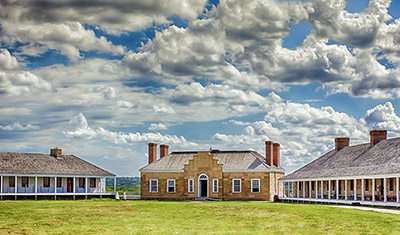 Enlisted Barracks to the left, Commanding Officer's Quarters in the middle, Officer's Quarters on the right, what the sky always looks like in Minnesota above. Enlisted Barracks to the left, Commanding Officer's Quarters in the middle, Officer's Quarters on the right, what the sky always looks like in Minnesota above. |
|
By 1820 Leavenworth's troops had started stacking rocks atop one another in the hopes that they'd wind up with a cool fort, and Colonel Josiah Snelling showed up to supervise construction. The resulting fort was initially named Fort St. Anthony, and while I'd like to definitively report that this referred to Anthony of Antioch (died 302AD), who was a desert hermit who existed on roots and vegetables and practiced celibacy (probably easy to achieve if one exists on roots and vegetables) and was persecuted unto death by Roman Emperor Diocletian (244-312)...but the world of Catholic saints is a bewildering one, and it may have referred to any of a number of other tragically martyred dudes named Anthony.
|
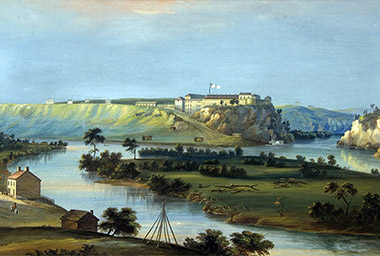 Fort Snelling by John Caspar Wild, 1844. Fort Snelling by John Caspar Wild, 1844. |
 |
Whichever Anthony was the Anthony, the War Department renamed the fort after Colonel Snelling in recognition of his contribution to the cause of American fortedness. The troops at Fort Snelling were expected to simultaneously curb British influence in the region, enforce boundaries betwixt Indian nations, and prevent ambitious white settlers from encroaching on Indian lands (at least until treaties could be worked out so that these encroachments would be all legal 'n' stuff).
Things were disappointingly uneventful in the region, however, and Fort Snelling's garrison spent most of the next 40 years farming crops, tending to gardens and chopping the massive loads of firewood necessary to survive through the Minnesota Territory winters. |
|
Full disclosure time: If you haven't yet noticed, Fort Snelling is no starfort. It is essentially a stockade fort, though it is walls are masonry instead of the usual wood. Stockade forts made perfect sense in the American west, where those interested in attacking them wouldn't be armed with artillery of any sort, and thus the added expense of a full-on starfort was unnecessary. The design is that of four strongpoints, with curtain walls connecting them. Fort Snelling's most interesting fortificational entity from a starfortesque point of view would be its Half-Moon Battery, directly behind the Commanding Officer's Quarters, and facing the confluence of rivers the fort was meant to defend.
Minnesota became the 32nd United State on May 11, 1858, by which time the wild frontier had moved away. Fort Ridgely (1851) and Fort Abercrombe (1858) had been built further to the west to confront the Dakota and/or Sioux, and Fort Snelling was no longer considered necessary for the defense of the realm.
|
But security brought prosperity, and the land in the Fort Snelling region was being snapped up by interested parties. Franklin Steele (1813-1880) was one such party: He had worked as a storekeeper within the fort for some years, went on to become a success in the lumber industry, and in 1858 purchased Fort Snelling and 20 square miles around it from the government for $90,000. Steele's intent was to sell off lots of this property and found a city, which he creatively imagined would be called "Fort Snelling."
|
 |
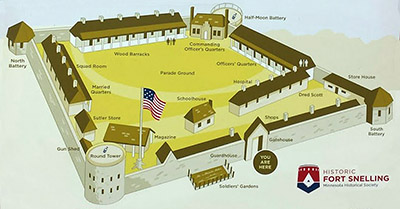 A map of Fort Snelling from a sign at the gate. You are here. |
|
Steele's scheme was put on hold by the American Civil War (1861-1865). He leased Fort Snelling back to the state of Minnesota for the duration, and it served as an induction center and training facility for Union troops. By 1863 a number of support buildings had popped up outside Fort Snelling's walls, and at the end of the conflict over 250,000 soldiers had cycled through the fort.
And a good thing too, as the Injuns needed' quellin'. In August of 1862, a small Dakota hunting party killed five white settlers in Acton Township, about 90 miles west of Fort Snelling. Upon returning to their village and describing their actions, a Dakota council decided that killing white folks was a fine idea, given their clear intent of failing to live up to their numerous treaty negotiations, and attacks on settlers thereafter became widespread.
|
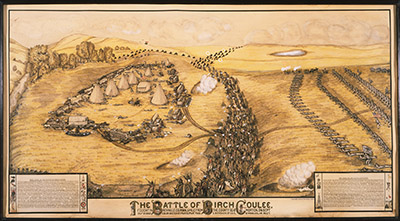 A lovely 1912 lithograph depicting the Battle of Birch Coulee by Paul G. Biersach, which battle took place on September 2, 1862, 100 miles to the west of Fort Snelling on the Minnesota River. While this battle has no immediate link to Fort Snelling, it was the deadliest battle of the US-Dakota War for the US Army (13 dead, 50 wounded, 90 dead horses), and it's such a pretty lithograph. A lovely 1912 lithograph depicting the Battle of Birch Coulee by Paul G. Biersach, which battle took place on September 2, 1862, 100 miles to the west of Fort Snelling on the Minnesota River. While this battle has no immediate link to Fort Snelling, it was the deadliest battle of the US-Dakota War for the US Army (13 dead, 50 wounded, 90 dead horses), and it's such a pretty lithograph. |
 |
800-ish settlers were killed by the Dakota in this conflict, and the US Army responded in a manner one might expect: With overwhelming force, once it got its act together.
38 Dakota men were hanged in Mankato, Minnesota in December of 1862, the largest mass execution in American history. Many prisoners were held at Fort Snelling, and several were hanged there as well. An internment camp was established on Pike Island, just under Fort Snelling, where 1600 Dakota women, children and old men were held for several months during the conflict: Around 300 died from disease. The Dakota were thereafter expelled from the region, their reservations un-reserved. |
|
At the price of being almost completely wiped out of existence, the Dakota had accomplished their goal of driving white settlers from much of the Minnesota River Valley and surrounding plains, but by the 1870's the area had been resettled by white folks. Say what you will about white folks, but they sure can settle.
Much of the Fort Snelling tract was returned to Franklin Steele in 1867. He leased parcels of the land out to settlers, and Minneapolis was incorporarated as a city in 1867, much of whose land came from the Steele/Snelling axis. Today there is a Steele County in Minnesota, and a Franklin Steele Square in Minneapolis.
|
Recognizing the ongoing threat presented by unhappy Indians, and unwilling to be caught with its pants down again, the United States established the Department of Dakota in August of 1866. This organization, which oversaw military activity and forts in Minnesota, Dakota- and Wyoming Territories, was initially headquartered at Fort Snelling.
Our fort expanded to fulfill this new role, then expanded more during the Spanish-American War (1898) and even more during the First World War (1914-1918). Much as it had during the Civil War, Fort Snelling served as a processing station for Minnesotans recruiting into the US Army. The post hospital was rechristened US General Hospital #29, and many damaged Doughboys returning from France were treated there.
|
 |
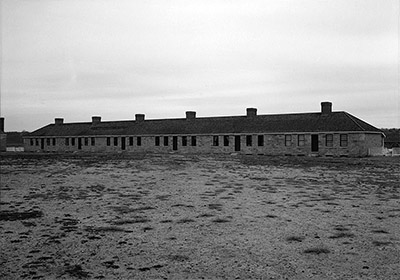 Fort Snelling's Officer's Quarters, sometime after 1933 but before folks knew how to grow grass on a fort's parade ground. |
|
Life for Fort Snelling's garrison appears to have been pretty sweet through the 1920's: Swimming pools, a golf course, polo grounds and no possibility of any sort of hostility in the region (Canada had ceased being a bloodthirsty, murderous nation bent on North American conquest once the British left in the late 1860's) all conspired to make Fort Snelling the "country club of the army."
The Civilian Conservation Corps rolled in and sprinkled even more structures around the extended Fort Snelling in the 1930's, and by the time large numbers of US males were entering military service following the Japanese attack on Pearl Harbor in December of 1941, Fort Snelling was a vast, 1521-acre complex that was ready to start processing.
|
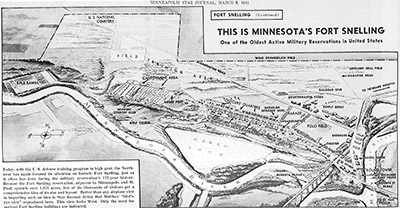 A gorgeous drawing of the extended Fort Snelling by Bob Matthes, from the Minneapolis Star Journal, March 9, 1941. Y'know what is not represented in this drawing? Fort Fricking Snelling. As we are all well aware, it should be right there where the Minnesota meets the Mississippi. For shame, Mr. Matthes.
To be fair, the Fort Snelling that stands today is a reconstruction, committed by the Minnesota Historical Society sometime after the war...so it's distinctly possible that there was no Fort Snelling for Mr. Matthes to draw! |
 |
Ultimately over 300,000 inductees were processed through Fort Snelling during the Second World War (1939-1945). The fort was also the base for a number of specialty units, such as a unit of Norwegian-speaking troops who were trained to fight on skis and snowshoes.
Fort Snelling was decommissioned in October of 1946. There remained a lot of support buildings on the extended Fort Snelling, and though the military retained a small presence in some of them, there was no longer any infastructure in place to maintain everything. The site was listed as a National Historic Landmark in 1960, and there were doubtless hopes that "landmark" status would save all those tumbling buildings. |
|
Today, most of those tumbling buildings are still tumbling. On the extended fort grounds is the Fort Snelling National Cemetery, where over 225,000 heroic dead folks, mostly of a Minnesotan military bent, are buried. The Minnesota Historical Society has rebuilt the original Fort Snelling, opened it to the public and it is manned (and no doubt womanned) by helpful souls in period dress through the spring, summer and early fall each year.
|
|
|
¹There is no historical evidence which suggests that Napoleon ever possessed, much less wore, "selling pants."
²How Napoleon predicted that the Louisiana Territory would include land from fifteen future US states, but somehow did not predict the outcome of the Battle of Waterloo (June 18, 1815), is anybody's guess.
³Actually the US Congress made this purchase, but it's more fun to think of Thomas Jefferson handing Napoleon a giant sack full of cash.
|
|
|
|
|
|
 |




